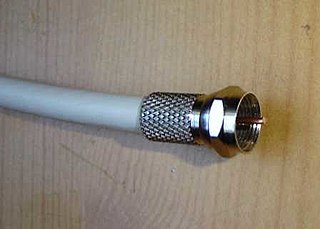
Cable television is a system of delivering television programming to consumers via radio frequency (RF) signals transmitted through coaxial cables, or in more recent systems, light pulses through fibre-optic cables. This contrasts with broadcast television, in which the television signal is transmitted over-the-air by radio waves and received by a television antenna attached to the television; or satellite television, in which the television signal is transmitted over-the-air by radio waves from a communications satellite orbiting the Earth, and received by a satellite dish antenna on the roof. FM radio programming, high-speed Internet, telephone services, and similar non-television services may also be provided through these cables. Analog television was standard in the 20th century, but since the 2000s, cable systems have been upgraded to digital cable operation.
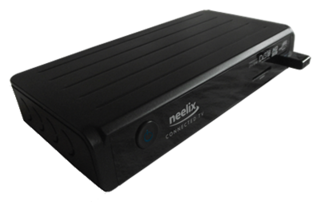
A set-top box (STB), also colloquially known as a cable box or receiver and historically television decoder, is an information appliance device that generally contains a TV-tuner input and displays output to a television set and an external source of signal, turning the source signal into content in a form that can then be displayed on the television screen or other display device. They are used in cable television, satellite television, and over-the-air television systems as well as other uses.

TiVo is a digital video recorder (DVR) developed and marketed by Xperi and introduced in 1999. TiVo provides an on-screen guide of scheduled broadcast programming television programs, whose features include "OnePass" schedules which record every new episode of a series, and "WishList" searches which allow the user to find and record shows that match their interests by title, actor, director, category, or keyword. TiVo also provides a range of features when the TiVo DVR is connected to a home network, including film and TV show downloads, advanced search, online scheduling, and at one time, personal photo viewing and local music playback.
The Digibox is a device marketed by Sky UK in the UK and Ireland to enable home users to receive digital satellite television broadcasts from the Astra satellites at 28.2° east. An Internet service was also available through the device, similar in some ways to the American MSN TV, before being discontinued in 2015. The first Digiboxes shipped to consumers in October 1998 when Sky Digital was launched, and the hardware reference design has been relatively unchanged since then. Compared to other satellite receivers, they are severely restricted. As of 2020, Sky Digiboxes have become largely outmoded, superseded by Sky's latest-generation Sky Q boxes and Sky Glass televisions; the previous generation Sky+HD boxes are still in use, however.
A digital video recorder (DVR) is an electronic device that records video in a digital format to a disk drive, USB flash drive, SD memory card, SSD or other local or networked mass storage device. The term includes set-top boxes with direct to disk recording, portable media players and TV gateways with recording capability, and digital camcorders. Personal computers are often connected to video capture devices and used as DVRs; in such cases the application software used to record video is an integral part of the DVR. Many DVRs are classified as consumer electronic devices; such devices may alternatively be referred to as personal video recorders (PVRs), particularly in Canada. Similar small devices with built-in displays and SSD support may be used for professional film or video production, as these recorders often do not have the limitations that built-in recorders in cameras have, offering wider codec support, the removal of recording time limitations and higher bitrates.

High-Definition Multimedia Interface (HDMI) is a proprietary audio/video interface for transmitting uncompressed video data and compressed or uncompressed digital audio data from an HDMI-compliant source device, such as a display controller, to a compatible computer monitor, video projector, digital television, or digital audio device. HDMI is a digital replacement for analog video standards.
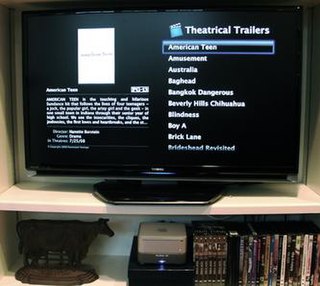
A home theater PC (HTPC) or media center computer is a convergent device that combines some or all the capabilities of a personal computer with a software application that focuses on video, photo, audio playback, and sometimes video recording functionality. Since the mid-2000s, other types of consumer electronics, including game consoles and dedicated media devices, have crossed over to manage video and music content. The term "media center" also refers to specialized application software designed to run on standard personal computers.

A tuner is a subsystem that receives radio frequency (RF) transmissions, such as FM broadcasting, and converts the selected carrier frequency and its associated bandwidth into a fixed frequency that is suitable for further processing, usually because a lower frequency is used on the output. Broadcast FM/AM transmissions usually feed this intermediate frequency (IF) directly into a demodulator that converts the radio signal into audio-frequency signals that can be fed into an amplifier to drive a loudspeaker.
A DVD recorder is an optical disc recorder that uses optical disc recording technologies to digitally record analog or digital signals onto blank writable DVD media. Such devices are available as either installable drives for computers or as standalone components for use in television studios or home theater systems.

CableCARD is a special-use PC Card device that allows consumers in the United States to view and record digital cable television channels on digital video recorders, personal computers and television sets on equipment such as a set-top box not provided by a cable television company. The card is usually provided by the local cable operator, typically for a nominal monthly fee.
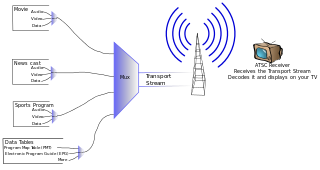
An ATSCtuner, often called an ATSC receiver or HDTV tuner, is a type of television tuner that allows reception of digital television (DTV) television channels that use ATSC standards, as transmitted by television stations in North America, parts of Central America, and South Korea. Such tuners are usually integrated into a television set, VCR, digital video recorder (DVR), or set-top box which provides audio/video output connectors of various types.
TiVo digital video recorders encompass a number of digital video recorder (DVR) models that TiVo Corporation designed. Features may vary, but a common feature is that all of the units listed here require TiVo service and use its operating system.
V+ is a set-top box for Virgin Media's Virgin TV service, which provides personal video recording (PVR) and high definition (HD) functionality to customers who subscribe to the service. Virgin TV have taken a different approach from rival Sky's Sky+ and later Sky+ HD services, by implementing a rental scheme for the V+ Box. When Virgin TV was launched, there was an installation charge and a monthly charge for all customers with a discount for XL customers. On 1 June 2007 pricing was revised, with all customers paying a one-off set-up fee and TV M and L customers paid a monthly charge, while TV XL customers had no extra charges. Various deals to lower the set-up fee have been made available to all customers in order to compete with rival Sky.
Various accessories for the PlayStation 3 video game console have been produced by Sony and third-party companies. These include controllers, audio and video input devices like microphones, video cameras, and cables for better sound and picture quality.

A digital television adapter (DTA), commonly known as a converter box or decoder box, is a television tuner that receives a digital television (DTV) transmission, and converts the digital signal into an analog signal that can be received and displayed on an analog television set. Some also have an HDMI output since some TVs with HDMI do not have a digital tuner. The input digital signal may be over-the-air terrestrial television signals received by a television antenna, or signals from a digital cable system. It normally does not refer to satellite TV, which has always required a set-top box either to operate the big satellite dish, or to be the integrated receiver/decoder (IRD) in the case of direct-broadcast satellites (DBS).
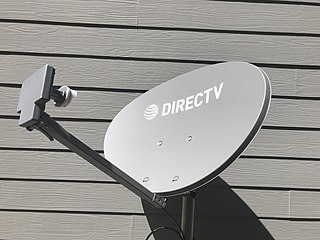
DirecTV is an American multichannel video programming distributor based in El Segundo, California. Originally launched on June 17, 1994, its primary service is a digital satellite service serving the United States. It also provides traditional linear television service delivered by IP through its U-verse TV brand and a Virtual MVPD service through its DirecTV Stream brand. Its primary competitors are Dish Network, traditional cable television providers, IP-based television services, and other over-the-top video services.
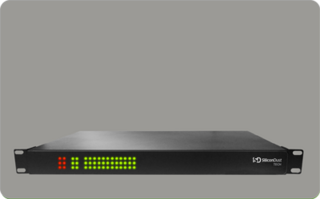
HDHomeRun is a network-attached digital television tuner box, produced by the company SiliconDust USA, Inc.

A cable converter box or television converter box is an electronic tuning device that transposes/converts channels from a cable television service to an analog RF signal on a single channel, usually VHF channel 3 or 4, or to a different output for digital televisions such as HDMI.
When a descrambler is added to the Cable Converter Box in the same chassis, it is referred to as a Converter/Descrambler or sometimes a Combination Unit, and is a type of Set-top box, it allows : local broadcast channels, basic cable channels, authorized premium channels, "Pay-Per-View" (PPV), and “Video On Demand” (VOD) services to be viewed. A Combination Converter/Descrambler is generally called a Set-top box or STB it is a single (one-piece) system installed in a single cabinet and represents a single component that is capable of descrambling premium services, like HBO or Showtime, pay-per-view cable channels., Video on Demand, Games or other specialty pay services, and transposes the cable signal for RF output on channel 3 or 4. This unit contains a converter and a descrambler, enclosed in a common box and outputs the signal directly to a TV, VCR, DVR, PC, DVD or video projector.
VidiPath is a set of guidelines developed by the Digital Living Network Alliance (DLNA) that enables consumers to view subscription TV content on a wide variety of devices including televisions, tablets, phones, Blu-ray players, set top boxes (STBs), personal computers (PCs) and game consoles without any additional intermediate devices from the service provider. Consumer Electronics (CE) products that are certified to the VidiPath Guidelines can directly support the full range of subscriber HD programs, movies, DVR content, channel guides, and other premium features, all with a consistent user interface (UI) from their service provider.











